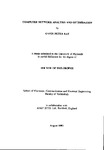COMPUTER NETWORK ANALYSIS AND OPTIMISATION
| dc.contributor.author | RAY, GAVIN PETER | |
| dc.contributor.other | School of Engineering, Computing and Mathematics | en_US |
| dc.date.accessioned | 2013-09-10T12:00:23Z | |
| dc.date.available | 2013-09-10T12:00:23Z | |
| dc.date.issued | 1993 | |
| dc.identifier | NOT AVAILABLE | en_US |
| dc.identifier.uri | http://hdl.handle.net/10026.1/1639 | |
| dc.description.abstract |
This thesis presents a study and analysis of the major influences on network cost and their related performance. New methods have been devised to find solutions to network optimisation problems particular to the AT&T ISTEL networks in Europe and these are presented together with examples of their successful commercial application. Network performance is seen by the user in terms of network availability and traffic delay times. The network performance is influenced by many parameters, the dominating influences typically being the number of users accessing the network, the type of traffic demands they place upon it and the particular network configuration itself. The number of possible network configurations available to a network designer is vast if the full range of currently available equipment is taken into account. The aim of this research has been to assist in the selection of most suitable network designs for optimum performance and cost. This thesis looks at the current differing network technologies, their performance characteristics and the issues pertinent to any network design and optimisation procedures. A distinction is made between the network equipment providing user 'access' and that which constitutes the cross country, or *core\ data transport medium. This partitioning of the problem is exploited with the analysis concentrating on each section separately. The access side of the AT&T ISTEL - UK network is used as a basis for an analysis of the general access network. The aim is to allow network providers to analyse the root cause of excessive delay problems and find where small adjustments to access configurations might lead to real performance improvements from a user point of view. A method is developed to allow statistical estimates of performance and quality of service for typical access network configurations. From this a general method for the optimisation of cost expenditure and performance improvement is proposed. The optimisation of both circuit switched and packet switched computer networks is shown to be difficult and is normally tackled by the use of complex procedures on mainframe computers. The new work carried out in this study takes a fresh look at the basic properties of networks in order to develop a new heuristic method for the design and optimisation of circuit switched core networks on a personal computer platform. A fully functional design system was developed that implements time division multiplexed core network design. The system uses both a new heuristic method for improving the quality of the designs and a new 'speed up' algorithm for reducing times to find feasible routes, thereby dramatically improving overall design times. The completed system has since been used extensively to assist in the design of commercial networks across Europe. | en_US |
| dc.description.sponsorship | AT&T ISTEL Ltd., Redditch, England | en_US |
| dc.language.iso | en | en_US |
| dc.publisher | University of Plymouth | en_US |
| dc.title | COMPUTER NETWORK ANALYSIS AND OPTIMISATION | en_US |
| dc.type | Thesis | en_US |
| plymouth.version | Full version | en_US |
| dc.identifier.doi | http://dx.doi.org/10.24382/1290 | |
| dc.identifier.doi | http://dx.doi.org/10.24382/1290 |
Files in this item
This item appears in the following Collection(s)
-
01 Research Theses Main Collection
Research Theses Main


